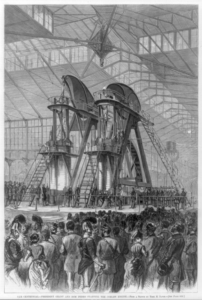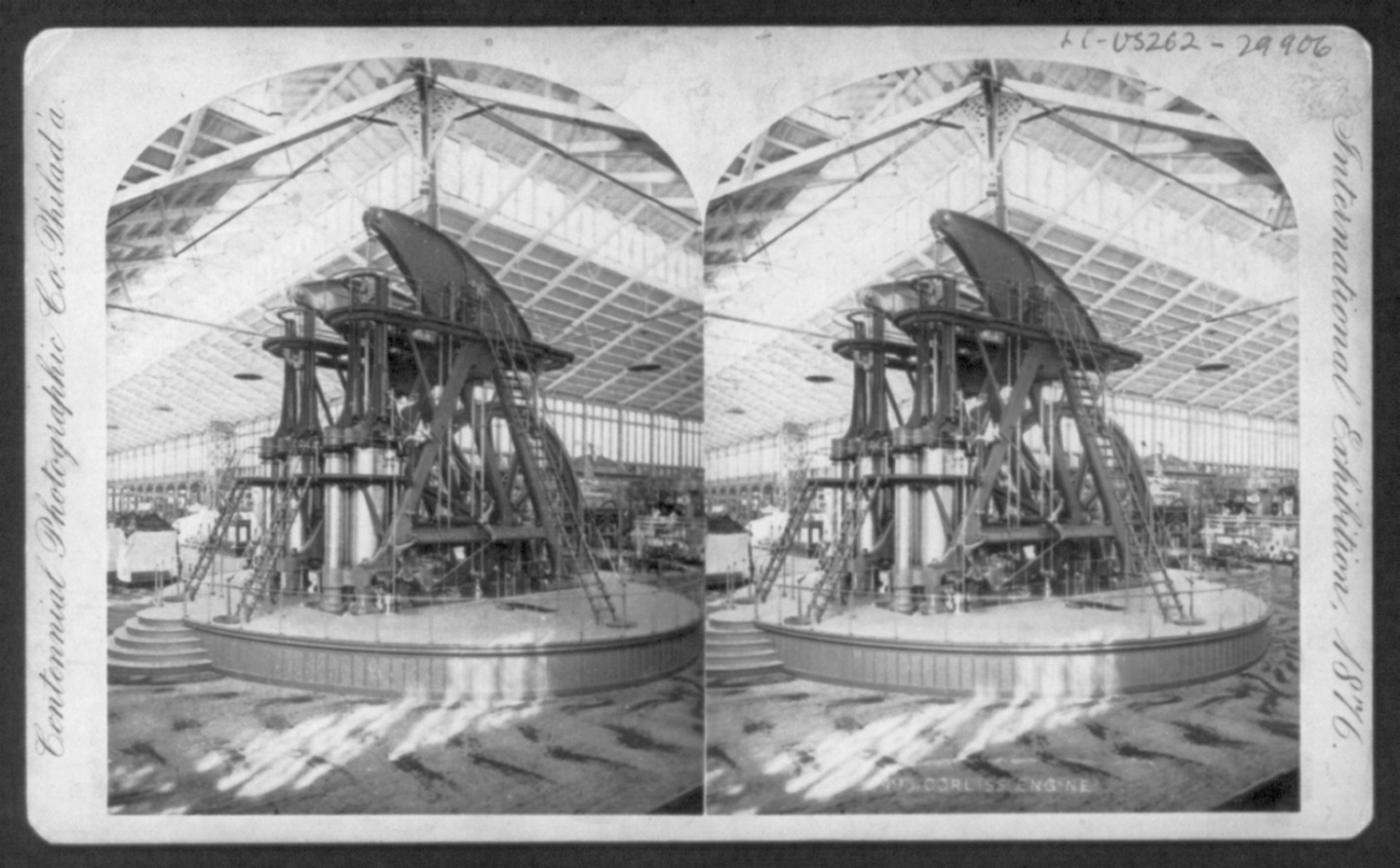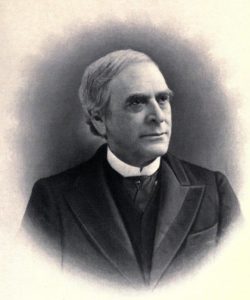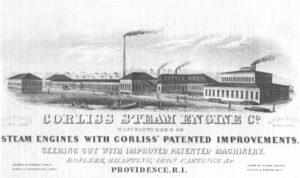Of all Rhode Island’s successful entrepreneurs, manufacturers, and inventors, none achieved more fame and notoriety in their lifetimes than George H. Corliss, the man whose refinements to the steam engine earned him international acclaim. His ancestors were among the earliest settlers of the Massachusetts Bay Colony, where his family resided until moving to Easton, New York, a Hudson Valley village about forty miles northeast of Albany, shortly after the American Revolution. Here George was born on June 2, 1817, to the former Susan Sheldon and Dr. Hiram Corliss, a versatile man who farmed, taught school, ran a general store, and practiced medicine.
The family, which eventually included nine children, moved to nearby Greenwich when George was eight. There he went to school and worked in the employ of a local factory store, where he inspected, measured, and sold cotton goods. His first engineering venture, while he was still only seventeen, was the design of a temporary bridge over a small local river, which he constructed in ten days with volunteer help. Perhaps this feat prompted his father to support additional formal education for George, who selected Castleton Seminary in Vermont for further schooling. He graduated in 1838, but returned to Greenwich to partner with his father in operating a general store. While selling shoes there, he fielded complaints from customers that the leather shoes they purchased split along the seams. The mechanically inclined Corliss sought to address this concern by devising a stitching machine designed for work on such materials as leather and sail cloth that could sew at twenty stitches a minute. On December 23, 1843, he patented the invention and prepared to embark upon a new career.
At that time the Providence-Pawtucket area had a national reputation for the manufacture of innovative machinery, so Corliss came to Rhode Island to find a builder for his sewing machine. He got a job as a draftsman in the shop of Fairbanks, Bancroft & Company, so he could raise funds to produce his invention and at the same time gain machine shop experience. Corliss’s ambition and talent coupled with the retirement of Edward Bancroft, led to the firm’s reorganization in 1847, when it became Corliss, Nightingale & Company, with thirty-year-old George as its president; and by 1856 it was simply the Corliss Steam Engine Company.
The upside of this business transformation was that Corliss and his company embarked upon the manufacture of steam engines as the firm’s principal product. The downside for Corliss was that he never put his sewing machine into production, so Elias Howe, originally of Spencer, Massachusetts, patented a slightly different version in 1846, manufactured it, and received the popular acclaim for being the machine’s inventor. To Howe’s credit, he later acknowledged publicly that “I did not invent the sewing machine. That honor belongs to George H. Corliss of Providence, Rhode Island, the noted engine builder.”
From 1847 onward, steam engine improvements and production became George’s passion and his great achievement. Lacking higher education to refine his talent, Corliss sought out Alexis Caswell, a Brown professor of mathematics, to instruct him in the properties of confined steam and the force it could exert. Armed with both genius and knowledge, in 1849 Corliss patented a governor with an automatic variable cut-off which made it possible for a steam engine to use only that amount of steam necessary to produce the required power with no loss of speed. Preventing the waste of steam by means of rationing it meant that less fuel (coal) was burned and production costs were sharply reduced. This slide valve mechanism operated on the same principle as Zachariah Allen’s 1834 cut-off valve, but it functioned differently. The similarities eventually led to a bitter legal and highly technical verbal battle between Allen and Corliss over their respective patents, with a court ruling in favor of Corliss.
Corliss also filed numerous complaints for patent infringement against others who copied him. In total, he reputedly spent over $100,000 on such litigation, much of it paid to his principal attorney, William H. Seward of New York, who was Abraham Lincoln’s secretary of state.
In his lifetime Corliss was issued forty-eight patents and twelve more, pending at his death, were issued later. Most involved improvements to what became known nationally as “the Corliss Engine,” but others related to such diverse items as pumps, a boiler with condensing apparatus, gear cutters, machine tools, and an elevator (which he installed in his mansion at 45 Prospect Street in Providence).
Immediately after creating his new firm, Corliss moved his operations from India Street to a much larger site on West River Street in Providence’s north end. At the time Corliss died in 1888, the company had grown to encompass nine acres and employ one thousand people. It was the most famous engine works in America during the country’s Age of Steam. Most of this vast plant has been destroyed, but the street on which Providence’s mechanized main post office is located bears the Corliss name.

President Grant helps to start the Corliss engine at the Centennial Exhibition in Philadelphia, 1876
It was at the West River Street plant that refinements were made to the Union vessel Monitor in 1862 to prepare it for the first battle of ironclad ships. Built at the Brooklyn Navy Yard according to the designs of Swedish inventor John Ericson, the Monitor had a revolving gun turret, but no factory in New York was capable of machining the large bearing on which the turret’s operation depended. Corliss had such equipment, so the Monitor’s huge ring was rushed by train to Providence, worked on, and returned to Brooklyn on the same day to make the Monitor ready for its epoch-making duel with the Confederate Merrimac.
In the ensuing years the Corliss works produced thousands of steam engines for use throughout America and won numerous national and international awards for excellence in function and design, including coveted Rumford Medals from the American Academy of Arts and Sciences.
Corliss’s crowning glory came in 1876 at the centennial celebration of the Declaration of Independence. Corliss was invited to help plan a mammoth Philadelphia exhibition of American achievements. Its centerpiece was a 776-ton Corliss engine that was forty feet high with a flywheel thirty feet in diameter and weighing eleven tons. The wheel meshed with a pinion shaft that was 325 feet long and delivered power to the hundreds of machines that were on display in the exhibition’s thirteen-acre main hall. The Centennial Engine, as it was called, was built in Providence and shipped by train on seventy-one flat cars to Philadelphia. Corliss, a devout Congregationalist, refused to place his engine in service on the scheduled Sabbath Day, so on Wednesday, May 10, 1876, as the spectators stood in awe, George, his wife Emily, President Ulysses Grant, and Brazilian emperor Dom Pedro II presided over the start-up ceremony, making the great wheel revolve to set in motion the intricate mechanisms that powered eight thousand machines throughout the vast hall.
Corliss spent $100,000 on his prize creation, which ran flawlessly during the six-month festival. The engine was then bought for $62,000 by George Pullman, of railroad-car fame, for his company town in Illinois. After much use, in 1905, as electricity replaced steam power, the famed machine was sold for scrap at a price of $7,892.50!
George Corliss did not have far-ranging interests other than his work, except for his skill as an architect. He dabbled a little in politics, serving in the Rhode Island General Assembly from 1868 to 1870. He also was a Republican elector in the highly disputed Rutherford Hayes-Samuel Tilden presidential contest of 1876, decided in favor of Republican Hayes by one electoral vote. Corliss was married twice, first in 1839 to Phoebe Frost, who died in 1859 after providing him with a son and a daughter, and then in 1866 to Emily Shaw, from his ancestral hometown of Newburyport
For his second wife, who was considerably younger, Corliss built a splendidly designed mansion at 45 Prospect Street with a stunning interior, an advanced radiant heating system with thermostats, and an hydraulic elevator from the basement to the third floor. He died in this mansion (which he called Emily’s “Bermuda home”) on February 21, 1888. Emily long survived him, living until 1910, but her husband’s business did not; it failed in the disastrous national economic Panic of 1893.
[Banner Image: A photograph of the Corliss engine at the Centennial Exhibition in Philadelphia, 1876 (Library of Congress)



























